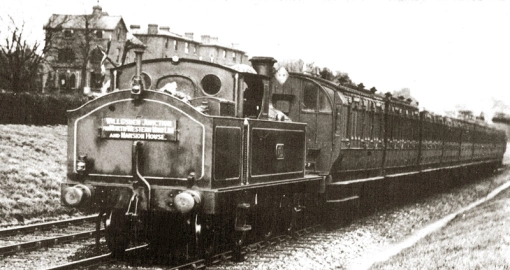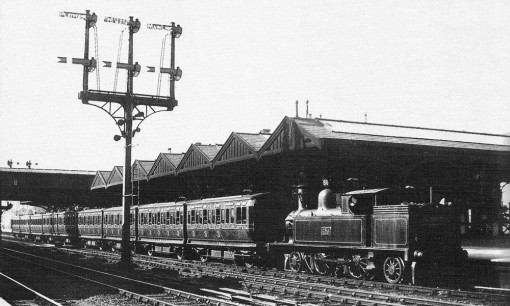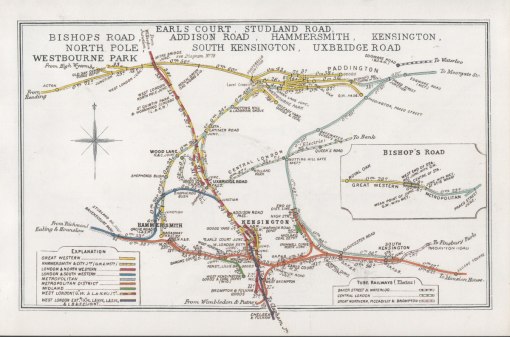Brown Trains. Nothing to do with the standard of service!
In 1890 – 1891 the London & North Western Railway built ten new trains of eight 4-wheel carriages in two batches of five for its Broad Street to Mansion House services. These eighty 28′ coaches were built as renewals of much older stock which had been used on the line since 1872, and in 1897 ten new Thirds with a 1′ shorter wheelbase were built on the capital account to strengthen the trains.
As built, the Mansion House sets were formed from Diagram 120 Firsts, Diagram 300 Seconds, Diagram 300 Thirds, Diagram 395 Brake Seconds and Diagram 395 Brake Thirds, and I intend to build Set No.7 in the pre-1897 eight carriage format. The photograph above shows Set No.7 c1904 with the additional Third.
The formation and running numbers of Set No.7 are all known:
Brake Second #96, Second #187, Second #165, First #266, First #118, Third #439, Third #825, Brake Third #272. These carriages were all gas lit and built on 18′ 0″ wheelbase steel channel underframes. In 1897, Third #2236 was added to the set and marshalled next to Brake Third #272.
Both the Brake Thirds and Brake Seconds had three compartments, and throughout the train there were only two compartment sizes; 6′ 10″ wide for Firsts, and 5′ 5″ for inferior classes. this explains the duplicate Diagram numbers for the Brake Seconds & Brake Thirds and the duplicate Diagram numbers for the Second & Third class carriages – to all intents and purposes they were identical, with the exception that in the all-Thirds, the compartment partitions were only to shoulder height.
These carriages were not painted in the famous L&NWR plum & spilt milk livery, but instead finished in varnished Burma teak which was considered by the company a better finish than paint to resist the continuous sulphurous atmosphere of the sub-surface lines. The stock was unlined and class designations were in the form of a large gilt numeral on the lower panel of the doors. The appearance of these sets soon earned them the soubriquet ‘The Brown Trains’.
16′ long roof boards were carried by the carriages, a little narrower than the 8″ wide roof boards carried by main line stock, and these carried the legend:
BROAD STREET, WILLESDEN, KENSINGTON & MANSION HOUSE. CHANGE AT WILLESDEN FOR MAIN LINE.
Trains destined for Bishospgate carried these boards on the 1st, 3rd, 5th & 7th carriages in the sets whereas the 2nd, 4th, 6th & 8th carriages carried boards lettered:
MANSION HOUSE, WAPPING, BASILICA FIELDS & BISHOPSGATE for BROAD STREET.
All the carriages had small 3′ boards on the sides above the windows lettered LONDON & NORTH WESTERN TRAIN in black on white.
The sets were gas lit as built, but in 1902 were converted to Stone’s electric lighting, each carriage was then fitted with dynamos and twin cell boxes. The lower footboards under the guard’s doors were removed at the same time as the conversions, but steam heating was never fitted.
With the electrification of the District Line in 1905, the majority of trains were hauled by the District Railway’s electric locomotives, with the exception of those few continuing on to the Extended Circle and Bishopsgate via Basilica Fields, until cessation of service in 1908.
At this time there are no kits for the Brown trains available commercially in 7mm. London Road Models have brass kits in 4mm, but I’m seriously considering producing artwork for etching as an aid to building them.


